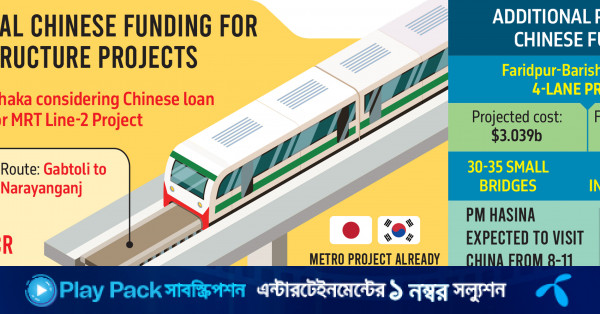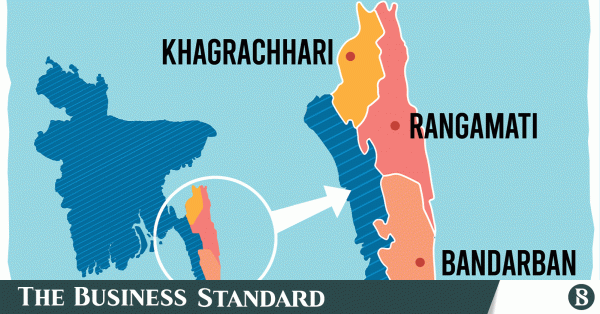Govt to seek Chinese loan for 35km Gabtoli-Narayanganj metro line


In a strategic move to strengthen Bangladesh’s infrastructure, Prime Minister Sheikh Hasina will seek funds from China for the construction of the 35-kilometre Mass Rapid Transit (MRT) Line-2, stretching from Gabtoli to Narayanganj, during her upcoming visit to Beijing, according to officials from the Economic Relations Division (ERD).
The projected cost of this project stands at a staggering Tk60,836 crore, equivalent to $5.2 billion, based on the current exchange rate of Tk117 per dollar.
Should China agree to finance this venture, it will mark the third instance of international collaboration on Bangladesh’s metro rail network, following investments from Japan and South Korea.
The prime minister is expected to visit China from 8-11 July.
According to the Dhaka Mass Rapid Transit Company Ltd, Tk45,626 crore of the total cost for the MRT Line-2 project is expected to be sourced from foreign loans, with the government funding the remaining amount.
ABM Amin Ullah Nuri, secretary of the Road Transport and Highways Division, told TBS that the ERD has the authority to seek foreign financing for development projects.
The Economic Relations Division (ERD) will finalise the source of funding for MRT Line-2. In this case, it can also communicate with China.
ABM Amin Ullah Nuri, secretary of the Road Transport and Highways Division
“The ERD will finalise the source of funding for MRT Line-2. In this case, it can also communicate with China,” he said.
“ERD’s decision is our decision in case of foreign financing,” he added.
MAN Siddique, managing director of Dhaka Mass Transit Company, said, “Development partners have already been secured to finance all MRT lines except Line-2. In this case, the government may seek financing from China.
“We will consider the loan interest rate, the commitment fee, and the length of the grace period. Taking all these factors into account, we will choose the financing source that offers the most favourable terms.”
In addition to MRT Line-2, Chinese financing may be sought for the Faridpur-Barishal and Barishal-Kuakata four-lane road construction project during the prime minister’s visit, according to ERD officials.
The project is estimated to cost $3.039 billion, with $2.579 billion proposed to be secured from foreign loans.
Senior officials at the Roads and Highways Department, speaking on condition of anonymity, said the project is also listed in their pipeline for implementation with ADB financing. However, the funding agency has expressed concerns about the project’s environmental impact.
Due to these concerns, the government is exploring alternative funding sources. The ADB has agreed to this approach, and the government is considering China as an alternative source.
ERD sources say China may announce funding for the construction of 30-35 small-scale bridges and disaster infrastructure in the country during the prime minister’s upcoming visit.
Additionally, an agreement on disaster management may be signed with China. Beijing may also sign an agreement with the Planning Commission regarding the process for approving development projects.
We will consider the loan interest rate, the commitment fee, and the length of the grace period. Taking all these factors into account, we will choose the financing source that offers the most favourable terms.
MAN Siddique, managing director of Dhaka Mass Transit Company
In 2016, a memorandum of understanding (MoU) titled Strengthening and Production Capacity Cooperation was signed during the visit of the President of China to Bangladesh. This MoU includes an assurance of implementing 27 projects worth $20 billion.
So far, loan agreements worth $8.076 billion for nine projects have been signed. ERD sources indicate that discussions during the prime minister’s visit may focus on expediting the signing of agreements for the remaining projects.
MRT Line-2 project update
The MRT Line-2, will extend to Narayanganj Sadar, passing through Gabtoli-Dhaka Udyan, Mohammadpur Bus Stand, Science Laboratory, New Market, Azimpur, Dhaka Medical College, Gulistan, Motijheel, Kamalapur, and Signboard. Additionally, a branch line will connect Gulistan to Old Dhaka’s Sadar Ghat.
According to DMTCL sources, the Preliminary Development Project Proposal (PDPP) for MRT Line-2 was submitted to the Physical Infrastructure Department of the Planning Commission on 12 December 2022, via the Road Transport and Highways Division.
After receiving in-principle approval from the Physical Infrastructure Department, the PDPP was forwarded to the ERD on 8 August 2023. Additionally, a request was made to the ERD on 24 January 2024, through the Road Transport and Highways Division to expedite the securing of foreign financing.
MRT Line-2 will interconnect with five other lines, including MRT Line-6 and MRT Line-1, both of which are being constructed with Japanese funding.
MRT Line-6 is now operational from Uttara to Motijheel, with the extension to Kamalapur completed.
South Korea has also engaged in the construction of metro rail in Bangladesh. The country will co-finance the construction of MRT Line-5 Southern Route in partnership with the ADB.
Additionally, MRT Line-2 will interconnect at the Gabtoli metro station with the ADB-funded MRT Line-5 Northern Route (Gabtoli to Aftabnagar), which is jointly funded by the ADB and Korea.
According to ERD sources, Korea has also committed to financing the MRT Line-4 (Kamalapur to Madanpur) project.
Faridpur-Barishal-Kuakata 4-lane project
According to the DPP, the proposed Faridpur-Barishal and Barishal-Kuakata Highways are the most important links of the National Highway network and it also constitutes a segment of the SASEC Road Corridor (SRC-4).
Currently, this is a two- lane highway with limited capacity and having no service lane. This causes frequent congestion which leads to significant safety hazards.
After the opening of the Padma Bridge, the road section has generated a huge volume of traffic facilitated by the Payra Sea Port and Kuakata tourist zone.
At present, the road is mostly characterised by unsatisfactory riding quality. Provided that the capacity of this 2-lane highway is constrained due to rapid growth of traffic.
The upgrading of this highway to a multilane dual carriageway with service lanes on both sides with major grade separations will significantly increase the capacity and safety of this important highway.




